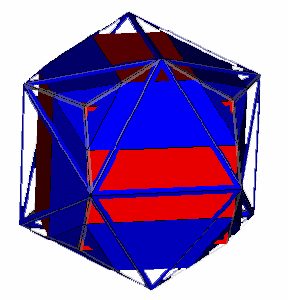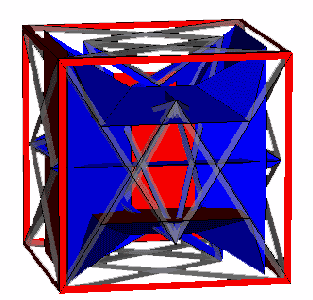
Dr Richard Klitzing's Convex Segmentochora
Dr Klitzing's 'Convex
Segmentochora' (pdf)
Table of VRML Files of all Convex Segmentochora
NEW
Segmentochora with free
symmetry [3,3]
Segmentochora with free symmetry [3,4]
Segmentochora with free symmetry [3,5]
Segmentohedra are polyhedra which can be obtained as segments of the uniform polyhedra or diminishings thereof (such as certain Johnson solids). They are sandwiched by a pair of parallel planes which contain all the vertices of a segmentohedron. Convex segmentohedra are prisms, antiprisms, pyramids and cupolae.
The image above illustrates a pentagonal cupola showing the two planes in which the vertices lie.
More generally, in n-dimensional space we speak of segmentotopes. Those are polytopes which meet the following conditions:
all vertices on a single hypersphere,
all vertices on a (not necessarily unique) pair of parallel hyperplanes,
all edges of unit length.
The first condition shows that the circumradius is well defined. Moreover, in union with condition 3 this implies that all faces have to be regular. Condition 2 implies that all edges which don't lie completely within one of the hyperplanes will join both, i.e. having one vertex in either plane. Other authors sometimes refer to polytopes meeting only condition 2 as prismatoids [1], those meeting 1 and 2 as exotic prisms or lace prisms [2].
From this definition it follows that the top and bottom figures are also polytopes with all vertices on a single circum-(hyper-)sphere. Further it follows from the definition that the laterals in turn have to be segmentotopes.
Dr Richard Klitzing has studied and listed all convex segmentochora (polychora are the 4-dimensional analogues of polyhedra). The definitions above are paraphrased from Dr. Klitzing's paper "Convex Segmentochora". A pdf version of the full paper is available here. A page containing links to VRML models of all of Dr Klitzing's Convex Segmentochora is available here.
The additional pages linked at the top supplement Dr Klitzing's paper. They catalogue Dr. Klitzing's images and VRML models of those convex segmentochora which show one of the higher axial symmetries, grouped by that symmetry. Some notes on the conventions used:
The top and bottom figures are shown in red and in blue, with the (distorted) lateral faces in gold. Dr. Klitzing names the segmentochora as "polyhedron A atop polyhedron B" (or A || B). The background colour signifies the space in which the figure exists.
co || sirco
The figure above gives an example with an outer rhombicuboctahedron (sirco) and an inner cuboctahedron (co). Lateral cells are six square antiprisms, twelve square pyramids and eight octahedra.

cube || ike |

cube || gike |
The above images show snapshots from two animations of segmentochora. The left image is an animation of cube || icosahedron, the right image is cube || great icosahedron. (Note that this is not included in Dr Klitzing's set of Convex Segmentochora as it is not convex, a 'still' model of this segmentochoron is here). The animations show the appearance of the segmentochoron at differing three dimensional realms as the viewpoint is moved from one polyhedral 'cap' to the other, the exterior framework of the segmentochoron is retained though. Clicking on either image will lead to the animated file.
Each segmentochoron of the great axial families is shown by a thumbnail image which links through to a VRML file. The VRML file in turn should be considered a 3-dimensional projection of the 4-dimensional figure. All VRML files (except for some of the trivial cases, and the animations above) were produced using HEDRON.
[1] Branko Gr°nbaum, 'Isogonal Prismatoids', Discrete and Comput. Geometry 18(1997), 13 - 52.
[2] Wendy Krieger, 'Polygloss',
online at http://www.geocities.com/os2fan2/gloss/index.html